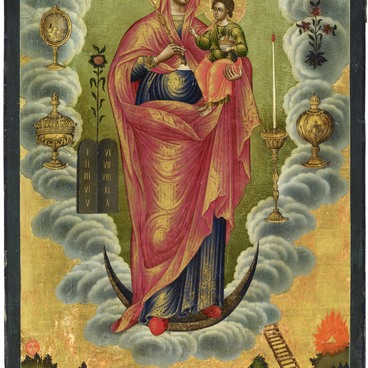The icon of Our Lady Soothe my Diseases is an example of the iconographic type of Hodigitria or Guide. The first icon of this kind was discovered in the ancient Christian church of Hodigon in Greece. Such icons usually show the Mother of God waist-high, holding the Child Jesus in her arms.
Our Lady Soothe my Diseases was a mirror image of the old icon of Our Lady Soothe my Sorrows. Both titles are quotes from the texts of church chants. Soothe my Sorrows was kept in a convent in the town of Shklov, on the territory of today’s Belarus, until the 17th century. The Virgin was painted with the Child, holding him with one hand, and touching her head with the other hand. In 1655, Shklov was captured by the troops of Tsar Alexei Mikhailovich, and the exact copies of this icon were brought to Moscow as trophies.
Our Lady Soothe my Diseases was a mirror image of the old icon of Our Lady Soothe my Sorrows. Both titles are quotes from the texts of church chants. Soothe my Sorrows was kept in a convent in the town of Shklov, on the territory of today’s Belarus, until the 17th century. The Virgin was painted with the Child, holding him with one hand, and touching her head with the other hand. In 1655, Shklov was captured by the troops of Tsar Alexei Mikhailovich, and the exact copies of this icon were brought to Moscow as trophies.

